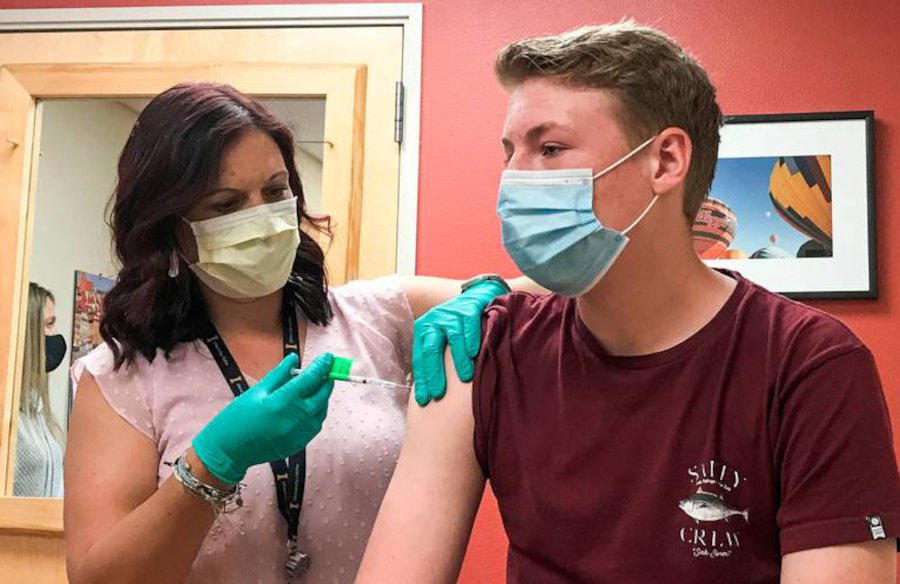COVID-19 cases in Idaho children have ‘skyrocketed.’ That could affect hospitals, care
Published at | Updated at
(Idaho Statesman)Adult intensive care unit beds at many Idaho hospitals are past capacity, a result of a COVID-19 surge that caused crisis standards of care to be implemented statewide.
What could complicate that already delicate situation is that infections among children have been soaring, meaning pediatric wards are filling up, too — and doctors and officials are worried that pinched resources eventually might affect the care available to teenagers and even younger kids, the Idaho Statesman reports.
“I worry every single day about the potential of seeing a child’s death notice,” Elke Shaw-Tulloch, Idaho Division of Public Health administrator, said through tears at a state news conference on Tuesday.
Though 10 Idahoans age 18 to 29 have suffered COVID-19-related deaths, so far no children in the state have died, according to data from the Idaho Department of Health and Welfare.
But COVID-19 cases among children are rising significantly faster than they are in adults, having doubled since mid-August. Infections in children now account for around 20% of new cases, according to Kathryn Turner, the state’s deputy epidemiologist.
Turner noted Tuesday that child infections have recently “skyrocketed,” with nearly 1,700 new cases reported the week starting Sept. 20. The peak in mid-December last year was just over 1,100 cases in a single week.
The rise in cases has corresponded with a more recent rise in hospitalizations, which has doctors concerned.
“We are seeing a spike, a new increase in pediatric patients admitted to the hospital who are testing positive for COVID,” Dr. Elizabeth Kleweno, the medical director for the pediatric hospital team at St. Luke’s Children’s Hospital, told the Idaho Statesman in September.
The symptoms children experience can vary, but often manifest as fever and congestion in infants, or — more often in adolescents — the severe respiratory disease that many adults experience, Kleweno said. Children with chronic medical conditions, such as diabetes or metabolic diseases, are particularly at risk.
Compared to adults, the number of pediatric hospital patients with COVID-19 is still small. At the start of September, there were just two at Idaho hospitals. As of Friday, there were 11, according to data from Health and Welfare. Since Sept. 24, there have been 25 total pediatric COVID-19 patients admitted to Idaho hospitals, according to data from the U.S. Department of Health & Human Services.
At St. Luke’s Children’s in Boise, the number of pediatric patients has increased from an average of around five patients per month to about 20 in September, according to Dr. Kenny Bramwell, system medical director at the hospital.
Since the pandemic began, 225 Idaho children have been hospitalized with COVID-19, and 32 have developed a post-infection illness called multisystem inflammatory syndrome, according to Health and Welfare data. The mysterious condition has been infecting children across the country and usually appears around four weeks after a child has been infected with the coronavirus.
Two of those cases were reported to Idaho’s Health and Welfare this week.
“What I’m worried about is that we have children who may either be asymptomatic or have very mild symptoms right now, but we could be seeing more cases of MIS-C (in the near future),” Turner said in an interview with the Statesman in September. “That’s what’s scary.”
In over half of those cases, Turner said, the children never get tested for COVID-19 while they actually have it. It is only once they are sick with the syndrome that they are tested, and doctors discover that they have developed natural antibodies to the virus, meaning they had an asymptomatic case or just very mild symptoms and didn’t realize it was the coronavirus.
Doctors say COVID-19 has been found to be very dangerous to pregnant women, and some babies have been born prematurely or with severe complications, because of a mother’s illness.
Nationally, 161 pregnant people have died of COVID-19 — 22 of them occurring in August, according to data from the Centers for Disease Control and Prevention.
In Idaho, Health and Welfare reports that there have been two pregnancy-related deaths, which includes women who die within one year of delivering a baby.
“We’re seeing an increase of babies who are born prematurely solely due to the mothers … having complications with their COVID disease,” said Dr. Nikolai Shalygin, a neonatologist at Mountain States Neonatology, at a press conference with Treasure Valley doctors on Wednesday. He said those babies are sicker than he would have expected, even though most have not tested positive for COVID-19.
Doctors are also beginning to see more stillbirths associated with mothers getting infected, according to Dr. Lauren Miller, perinatal health director at St. Luke’s, who also spoke Wednesday.
“That is very scary,” Miller said.
“I’m not coming up with any nice words to describe the way that the school boards have responded to this problem.”
She said her hospital is focused on vaccinating as many members of a family as are eligible in order to help protect children.
“We’ve just been begging and pleading for our moms and our families to trust us and to trust the information that we’re giving them,” Miller said. “Everything we have, as far as data, points to very good safety information for vaccination during pregnancy, as well as postpartum and during lactation.”
With childhood COVID-19 cases and hospitalizations on the rise, doctors are simultaneously anxious about the annual fall rise in other respiratory illnesses, which could affect care capacity. What some people aren’t considering, Miller said, is that masks can also help reduce the spread of illnesses other than COVID-19.
Cold and flu season already has arrived in Idaho, and doctors also are seeing an unusually early rise in a common illness in children called respiratory syncytial virus, or RSV. This compounds the problems caused by COVID-19.
“Now that everyone’s out and about again, the younger kids — 2 years old and younger — are getting exposed to RSV and they’re catching it now,” Kleweno said. And when you get a spike in multiple respiratory viruses at the same time, “that puts a big strain on the (pediatric) hospital systems.”
Few school boards in the state are requiring students to wear masks in school, despite evidence that face coverings reduce viral spread and recommendations from doctors and the Centers for Disease Control and Prevention.
In the Twin Falls region, the number of cases in children is now at three times the level seen in September 2020, according to a Friday news release from South Central Public Health District, which covers Blaine, Camas, Cassia, Gooding, Jerome, Lincoln, Minidoka and Twin Falls counties. Among children 6 to 17, the rates have nearly quadrupled, and schools in the region are also seeing high levels of impetigo, a highly contagious skin infection, and RSV, officials said.
“A little bit of extra illness when school starts is expected,” said Heather Park, the district’s school liaison, in the release. “But what we’re seeing now is far from normal. Our community is battling a wave of illness that continues to overwhelm our hospitals and is starting to affect our local schools’ ability to keep kids in class.
“Some local schools have been forced to temporarily shut their doors because so many staff are out sick, others are scrambling to find enough COVID-19 testing supplies because so many kids are coming to school sick.”
Crowds of parents have stormed recent school board meetings about possible mask mandates, prompting the Coeur d’Alene and Pocatello/Chubbuck school districts this week to cancel a discussion about a mask policy and to make masks optional, respectively. At the West Ada School District, a group of parents is attempting to recall the board chair in part because of her emphasis on health-safety measures in school settings.
RELATED | Masks remain optional in Pocatello/Chubbuck schools after new vote
In the Treasure Valley, the Boise and West Ada districts both have mask mandates in place, as does the Caldwell School District. West Ada started the school year allowing parents to opt out their children from wearing a mask, and about a third did, but as the crisis got worse, the district instituted a requirement with no opt-out.
“I’m not coming up with any nice words to describe the way that the school boards have responded to this problem,” Bramwell said on Wednesday. “They don’t seem to understand the importance of masks in public settings. … Because of inactivity from our president and our governor, we have left the public health decisions up to school boards, which they really have no interest in doing.”
Dr. David Peterman, a pediatrician and the CEO of Primary Health Medical Group, called the behavior of some school boards “shameful” on Wednesday and pointed to data from Primary Health that indicates fewer children are testing positive in the few Idaho school districts that have required masks.
Vaccinations among eligible children (12 and older) have been slow to gain a foothold in the state, with only 28% of 12- to 15-year-olds and 35% of 16- to 17-year-olds fully vaccinated, according to Health and Welfare.
“These are patients who, I’ve taken care of their kids for 15 years,” Peterman said. “I have given them advice, which they’ve taken on influenza vaccines, multiple other childhood vaccines, and sometimes antibiotics and whatnot, and they’re very comfortable with that advice. And yet with so much misinformation on this particular vaccine, they’re not willing to listen.”
Bramwell emphasized that the situation in pediatric units is not yet the “catastrophe” of “panic-level admissions” currently being seen on adult floors in hospitals, but because of its number of patients and space restraints, St. Luke’s is considering admitting some younger adult COVID-19 patients — 18 to 21 — to its children’s hospital.
The health system had 264 adult COVID-19 patients hospitalized as of Thursday, according to its data dashboard.
“We are running out of real estate,” he said.
And if patient levels keep rising, that could affect the care available to children, Bramwell added.
“Our biggest concern is that these cases will continue to rise,” he said.



